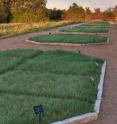Lawn of native grasses beats traditional lawn for lushness, weed resistance
Related images
(click to enlarge)
A lawn of regionally native grasses would take less resources to maintain while providing as lush a carpet as a common turfgrass used in the South, according to a study by ecologists at The University of Texas at Austin's Lady Bird Johnson Wildflower Center. "We created a lawn that needs less mowing and keeps weeds out better than a common American lawn option," said Dr. Mark Simmons, director of the center's Ecosystem Design Group, noting that this new approach could have a huge impact on pocketbooks and the environment.
Simmons led the study comparing common Bermudagrass to seven native grasses that will be published online this week in the journal Ecological Engineering.
Commercial and residential lawns cover about 40 million acres – more American landscape than any traditional agricultural crop. But keeping that turfgrass looking good takes more time, effort and money than it could and carries an environmental price tag.
U.S. lawn maintenance annually consumes about 800 million gallons of gasoline, $5.2 billion of fossil-fuel derived fertilizers and $700 million in pesticides. Up to two thirds of the drinking water consumed in municipalities goes to watering lawns.
"Most lawns use a single grass species, which requires inputs to maintain," Simmons said. "The goal was to develop a more ecologically stable, natural alternative for lawns that are so important to many Europeans and Americans."
Simmons knew that the species co-existing in natural grasslands can thrive without human intervention from living and studying in southern England near where Jane Austen once lived, and in the grasslands of South Africa. To test whether a mixture of grasses provides a good lawn, Simmons and colleagues Michelle Bertelsen, Dr. Steve Windhager and Holly Zafian used funding from Walmart to establish multiple plots of grasses in an open field at the center.
Co-author Bertelsen is an ecologist at the Wildflower Center. Windhager previously directed landscape restoration research at the center and is now chief executive officer of the Santa Barbara Botanic Garden. Zafian was a center research assistant and is now a graduate student at Texas State University – San Marcos.
For the study, plots of non-native Bermudagrass were established from commercially available seeds alongside plots of Buffalograss in various combinations with other native, short grass species. In 2009, the researchers applied different mowing and other regimes to the two-year-old turf plots.
The traditional turfgrass and the native grasses responded the same to mowing once or twice a month, to two watering regimens and to the equivalent of foot traffic. However, the turf of seven native grasses produced a carpet that was 30 percent thicker in early spring than the Bermuda turf. As temperatures climbed into mid-summer and all the lawns thinned, the mixed native turfgrass still stayed 20 percent thicker than Bermuda.
"If we had mowed more frequently, the Bermudagrass might have become denser because of the way it grows," Simmons said, "but the point was to find something that took less work to maintain than Bermuda and other traditional turfgrasses."
Although Buffalograss also retained its lushness into summer, the mixed native turfgrass beat both single species (monoculture) turfgrasses in weed resistance. When dandelion seeds were added by hand, those plots grew half as many dandelions as the Buffalograss or Bermudagrass plots.
To see if the mixed native turfgrass would also outperform the others under conditions such as very light watering, he and his colleagues will conduct the next research phase later this year. The answer under some conditions will likely be a yes because the multiple species in natural grasslands are thought to allow them to respond better to different conditions over time.
How soon American lawns benefit from the findings depends partly on whether native grasses become more commercially available. The native grass combination that will likely work best will also vary with location, Simmons noted.
"This is just the first step to showing that having multiple grass species, basically creating a stable ecosystem that is a lawn, may have advantages for some turfgrass applications," Simmons said. "But we need to apply the findings to different settings to move away from solely having lawns that rely on us for life support."
Source: University of Texas at Austin
Other sources
- Lawn of native grasses beats traditional lawn for lushness, weed resistancefrom Science DailyThu, 21 Apr 2011, 16:31:58 UTC
- Lawn of native grasses beats traditional lawn for lushness, weed resistancefrom Science BlogThu, 21 Apr 2011, 16:01:46 UTC
- Lawn of Native Grasses Beats Traditional For Lushness, Weed Resistancefrom Newswise - ScinewsThu, 21 Apr 2011, 16:01:21 UTC
- Lawn of native grasses beats traditional lawn for lushness, weed resistancefrom PhysorgThu, 21 Apr 2011, 14:31:22 UTC

